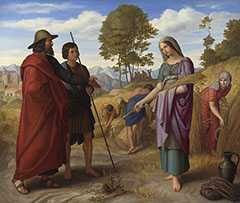
Ruth was not of the tribe of Israel, but from the neighbouring Moabite nation. The Moabites were enemies of the Israelites; nonetheless, this did not stop Ruth from making her mark on Judaism.
Ruth was the wife of an Israelite man who had come to settle in her land of Moab. He had arrived with his father and brother when their own land of Judah was struck by famine. Although the Israelites and the Moabites had been enemies, the family settled comfortably in the new land.
It came to pass that the father, Elimelech, died, leaving his wife Naomi with her two sons. The sons grew to marry Moabite women, Ruth and Orpah. Ruth did not follow the laws of Moses, yet she happily accepted her husband’s ways.
When the two brothers also died, their mother Naomi was devastated. Ruth and Orpah remained with Naomi in her house. The three women grew very close, remaining attached despite their devastating loss.
Naomi, overcome by her situation, and having heard that the famine had ended in her homeland, decided to return to Judah. Her daughters-in-law decided to go with her.
During the journey to Bethlehem (Naomi’s home town), Naomi was overcome with the burden the girls would carry, being uprooted from their homeland. She told them to turn back towards Moab. Orpah listened, yet Ruth refused in the following words: ‘Do not urge me to leave you, to turn back and not follow you. For wherever you go, I will go. Wherever you lodge, I will lodge. Your people shall be my people, and your God my God’ (Ruth 1: 16).
Ruth’s story emphasises the power of female friendship and the Divine Feminine, which Ruth and Orpah recognised in Naomi. Ruth found in her mother-in-law a spirit that was unknown to her own people.
Ruth’s loyalty towards her husband’s people clearly went beyond the bounds of family duty. She was prepared to give up everything she knew to go to Bethlehem with Naomi.
When she arrived in the new land, Ruth gathered the grain that had been dropped on the ground in order to feed herself and her mother-in-law. Because Ruth arrived in Bethlehem at the harvest time, her book is traditionally read on the harvest festival of Shavuot.
Naomi chose to settle in Bethlehem and instruct Ruth to go gleaning (gathering grain) in a field that belonged to Boaz. According to Biblical law, he, as a relative of Ruth’s late husband, was obligated to marry Ruth in order to carry on the family line. Ruth and Boaz married, producing a son called Obed, the grandfather of King David. Thus the importance of every Jew is emphasised in Ruth, a convert to Judaism who eventually produced a king of Israel.
Ruth’s example illustrates the power of love. Her inexplicable connection to the Israelites was based on an intense love, which led her to embrace the ways of the Hebrew Bible and become immortalized within it. Ruth’s story of a love that knew no cultural confines is retold each year amongst Jewish people. That she was not Jewish by birth became irrelevant once she found the Divine spirit in her heart.


